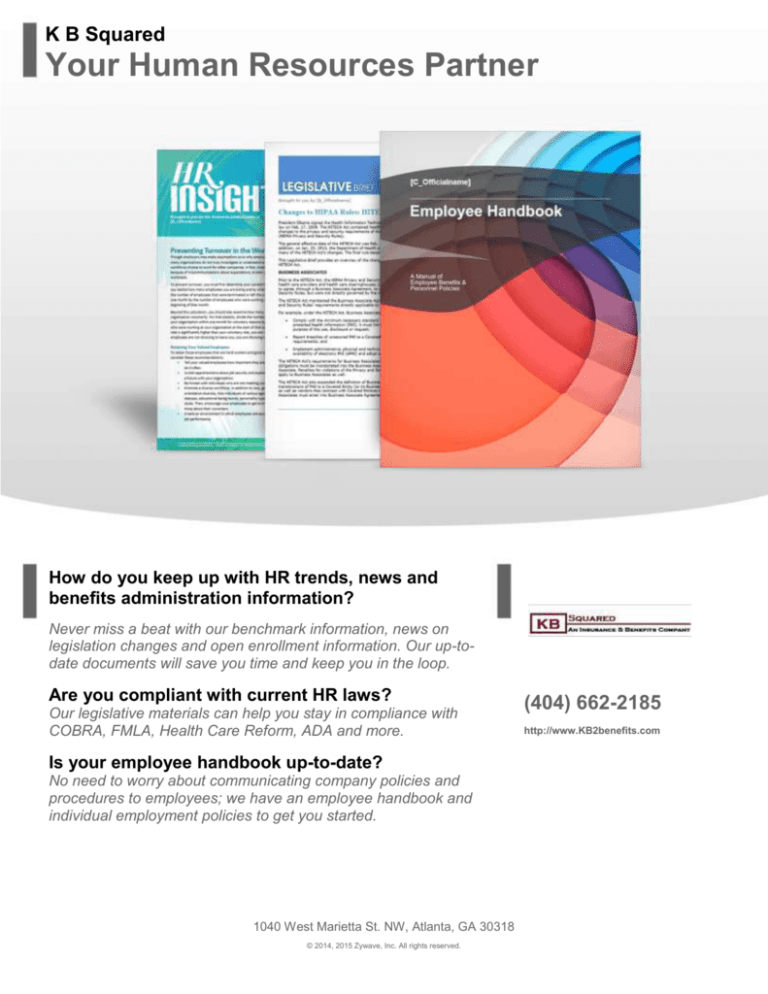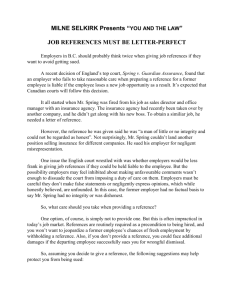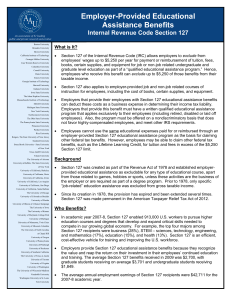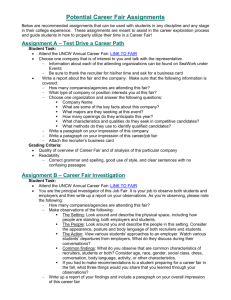
K B Squared
Your Human Resources Partner
How do you keep up with HR trends, news and
benefits administration information?
Never miss a beat with our benchmark information, news on
legislation changes and open enrollment information. Our up-todate documents will save you time and keep you in the loop.
Are you compliant with current HR laws?
Our legislative materials can help you stay in compliance with
COBRA, FMLA, Health Care Reform, ADA and more.
Is your employee handbook up-to-date?
No need to worry about communicating company policies and
procedures to employees; we have an employee handbook and
individual employment policies to get you started.
1040 West Marietta St. NW, Atlanta, GA 30318
© 2014, 2015 Zywave, Inc. All rights reserved.
(404) 662-2185
http://www.KB2benefits.com
Sample Documents
Table of Contents
Educational Resources
Health Care Reform: Pay or Play Penalty – IRS Examples for Determining Full-time Status ..3
Health Care Reform: What Does it Mean for You?.......................................................................4
Compliance Steps for the Final HIPAA Rule ................................................................................5
Avoid 10 Common ADA Mistakes .................................................................................................6
Preventing Turnover in the Workplace .........................................................................................7
HR Q&A: COBRA Notification Requirements - Employer Responsibilities ...............................8
Employer Tools
Benefits Buzz Newsletter ...............................................................................................................9
Employee Handbook Checklist ...................................................................................................10
Employee Handbook ............................................................................................................ 11 - 12
Total Compensation Statement Packet .............................................................................. 13 - 14
Employee Videos ..........................................................................................................................15
Brought to you by K B Squared
Pay or Play Penalty—IRS Examples for Determining Full-time Status
Under Section 4980H of the Affordable Care Act (ACA), applicable large employers (ALEs) may be subject to a penalty
if they do not offer health coverage to their full-time employees (and dependents), or if they offer coverage that is
unaffordable or does not provide minimum value. Employers with 50 or more full-time employees, including fulltime equivalents, on business days during the preceding calendar year are considered ALEs.
The employer shared responsibility rules were set to take effect on Jan. 1, 2014. However, on July 2, 2013, the
Treasury delayed the employer mandate penalties and related reporting requirements for one year, until
2015. Therefore, these payments will not apply for 2014. On July 9, 2013, the IRS issued Notice 2013-45 to provide
more formal guidance on the delay. No other provisions of the ACA were affected by the delay.
On Feb. 10, 2014, the Internal Revenue Service (IRS) issued final regulations on the ACA’s employer penalty
provisions. The final regulations include transition rules to help employers come into compliance with the employer
mandate. Under these rules, the employer mandate will generally apply to:
ALEs with 100 or more full-time employees starting in 2015; and
ALEs with 50-99 full-time employees starting in 2016.
LOOK-BACK MEASUREMENT METHOD
The ACA defines a full-time employee as an employee who is employed, on average, for at least 30 hours of service
per week. The final regulations provide guidance on an optional safe harbor method for identifying full-time employees
for purposes of calculating an employer’s potential liability for a shared responsibility payment. This method is called
the “look-back measurement method.”
To help explain the look-back measurement method for identifying full-time employees, the final regulations include
numerous examples. The examples address the methods for ongoing employees and new variable hour, part-time and
seasonal employees.
EXAMPLE OF ONGOING EMPLOYEES
Facts—Employer Z, an ALE, chooses to use a 12-month stability period that begins Jan. 1 and a 12-month standard
measurement period that begins Oct. 15. Consistent with the terms of Employer Z’s group health plan, only
employees classified as full-time employees using the look-back measurement method are eligible for coverage.
Employer Z chooses to use an administrative period between the end of the standard measurement period (Oct. 14)
and the beginning of the stability period (Jan. 1) to:
Determine which employees were employed, on average, 30 hours per week during the measurement period;
Notify them of their eligibility for the plan for the calendar year beginning on January 1 and of the coverage
available under the plan;
Answer questions and collect materials from employees; and
Enroll those employees who elect coverage in the plan.
This is a sample document provided by K B Squared and is for illustrative purposes only.
13
From
Health Care
Reform: What
Does it Mean
for You?
How the health care reform law affects you
varies greatly depending on your income,
who you work for and many other factors. So
what does it mean for you? Below is a list of
how health care reform affects different
groups of people.
Everyone: Beginning in 2014, every
individual must either have health insurance
that meets minimum standards of coverage
or pay a penalty when filing tax returns.
The penalty in 2014 is 1 percent of your
yearly income or $95 per adult for the year,
whichever is greater. For children, the
penalty is $47.50 per child, up to a $285
maximum per household.
The penalty increases every year. In 2015,
the fee will be 2 percent of income or $325
per person, whichever is greater. In 2016, it
will be 2.5 percent of income or $695 per
person, whichever is greater. After 2016, it
will increase with inflation.
Those who choose to pay the penalty and
remain uninsured will still be responsible for
100 percent of the cost of their medical care.
While the penalty applies to the vast majority of Americans, there are certain
exemptions. Uninsured people will not have to pay a penalty if they:
Are uninsured for fewer than three months of the year
Have low income and coverage is considered unaffordable
Are not required to file a tax return because their income is too low
Would qualify under the new income limits for Medicaid, but their state has
chosen not to expand Medicaid eligibility
Are a member of a federally recognized Indian tribe
Participate in a health care sharing ministry
Are a member of a recognized religious sect with religious objections to
health insurance
Health care reform affects each American differently based
on many factors.
Elderly: The elderly now receive free preventive services under Medicare, including
annual wellness visits and personalized prevention plan services. Once those with
Medicare prescription drug coverage enter the “donut hole” coverage gap, they will be
eligible for drug discounts and subsidies, until the donut hole is completely closed in
2020. Medicare beneficiaries earning $85,000 or more will pay higher Part B
premiums until 2019. High-income individuals will also pay higher premiums for
Medicare prescription drug coverage. Those with Medicare Advantage plans may
lose some benefits or experience an increase in copayments.
Employees of a large company: Employers with 50 or more employees will be
required to provide health coverage that is affordable and provides minimum value, or
pay a penalty. These rules take effect in 2015 for most large employers. Mid-sized
large employers with 50 to 99 employees may have an additional year, until 2016, to
comply with these coverage rules.
This article is provided by K B Squared. It is to be used for informational purposes only and is not
intended to replace the advice of an insurance professional. Visit us at
http://www.KB2benefits.com.© 2013 Zywave, Inc. All rights reserved.
This is a sample document provided by K B Squared and is for illustrative purposes only.
4
Brought to you by K B Squared
Changes to HIPAA Rules: HITECH Act
President Obama signed the Health Information Technology for Economic and Clinical Health Act (HITECH Act) into
law on Feb. 17, 2009. The HITECH Act contained health information technology provisions and also made significant
changes to the privacy and security requirements of the Health Insurance Portability and Accountability Act of 1996
(HIPAA Privacy and Security Rules).
The general effective date of the HITECH Act was Feb. 17, 2010, but some provisions had varying effective dates. In
addition, on Jan. 25, 2013, the Department of Health and Human Services (HHS) issued a final rule that implements
many of the HITECH Act’s changes. The final rule became effective on Sept. 23, 2013.
This Legislative Brief provides an overview of the changes made to the HIPAA Privacy and Security Rules by the
HITECH Act.
BUSINESS ASSOCIATES
Prior to the HITECH Act, the HIPAA Privacy and Security Rules directly applied only to Covered Entities - health plans,
health care providers and health care clearinghouses. Under the prior law, a Covered Entity’s Business Associates had
to agree, through a Business Associate Agreement, to comply with certain requirements of the HIPAA Privacy and
Security Rules, but were not directly governed by the regulations.
The HITECH Act maintained the Business Associate Agreement requirement, and made a number of the HIPAA Privacy
and Security Rules’ requirements directly applicable to Business Associates.
For example, under the HITECH Act, Business Associates are required to:
Comply with the minimum necessary standard so that when a Business Associate uses, discloses or requests
protected health information (PHI), it must limit PHI to the minimum amount necessary to accomplish the
purpose of the use, disclosure or request;
Report breaches of unsecured PHI to a Covered Entity in compliance with the Privacy Rules’ breach notification
requirements; and
Implement administrative, physical and technical safeguards to ensure the confidentiality, integrity and
availability of electronic PHI (ePHI) and adopt and implement policies and procedures for protecting ePHI.
The HITECH Act’s requirements for Business Associates generally became effective on Feb. 17, 2010. The additional
obligations must be incorporated into the Business Associate Agreement between the Covered Entity and Business
Associate. Penalties for violations of the Privacy and Security Rules that formerly applied only to Covered Entities now
apply to Business Associates as well.
The HITECH Act also expanded the definition of Business Associate to include organizations that provide data
transmissions of PHI to a Covered Entity (or its Business Associate) and require access on a routine basis to this PHI,
as well as vendors that contract with Covered Entities to offer a personal health record to patients. These Business
Associates must enter into Business Associate Agreements with the Covered Entities.
This is a sample document provided by K B Squared and is for illustrative purposes only.
5
Brought to you by the insurance professionals at
K B Squared
Avoid 10 Common ADA Mistakes
The ADA Amendments Act of 2008 broadened the definition of disability previously
established by the ADA and effectively expanded the group of people who would qualify
as disabled. The amendments put more pressure on employers to provide reasonable
accommodations and created more potential liability for companies that are not in
careful observance of the law. This article provides helpful guidance for employers to
follow, as well as common mistakes to avoid.
What Employers Can Do
There are steps employers can take to protect themselves from liability and prepare
their company in case of a future lawsuit.
Keep Job Descriptions Detailed and Accurate
It is important that job descriptions are kept up-to-date and include essential functions of
a job. Remember that employers generally have a responsibility to reasonably
accommodate an employee who cannot perform an essential function. However, an
employer does not have to eliminate an essential function of a job position as part of a
reasonable accommodation. Essential functions in a job description can be one factor in
legally proving that the task is indeed essential to the job; these functions can include
physical requirements like lifting or standing and stamina requirements like working long
hours or weeks.
Employers have specific
responsibilities under the
ADA; failure to adhere to
these responsibilities can
result in lawsuits and
significant penalties. There
are steps employers can
take to protect themselves
from liability and avoid
common ADA mistakes.
Develop an Accommodation Policy
Creating and distributing a reasonable accommodation policy can demonstrate your
commitment to honoring the ADA. The policy should direct all reasonable accommodation
requests to HR rather than to supervisors, as HR professionals are better equipped to deal
with the nuances and legal risks of handling these types of requests.
Train Supervisors
Even though you direct employees to HR, supervisors still need to know how to handle
the situation if a reasonable accommodation is requested of them. They should not
respond either yes or no to the request, regardless of how feasible it may or may not
be, but should instead refer the situation to HR. In addition, supervisors must be trained
to handle potential ADA situations that may arise during a job interview or in their daily
work with employees.
This is a sample document provided by K B Squared and is for illustrative purposes only.
6
This HR Insights is not intended to be exhaustive nor should any discussion or opinions be
construed as professional advice. © 2011-2013, 2015 Zywave, Inc. All rights reserved.
Brought to you by the insurance specialists at
K B Squared
Preventing Turnover in the Workplace
Though employers may make assumptions as to why employees leave the company,
many organizations do not truly investigate or understand why some of the best in their
workforce choose to work for other companies. In fact, most workers leave their jobs
because of miscommunications about expectations, broken promises or excessive
workloads.
To prevent turnover, you must first determine your current turnover rate. This will help
you realize how many employees you are losing and by what means. To do so, divide
the number of employees that were terminated or left the company voluntarily during
one month by the number of employees who were working at your organization at the
beginning of that month.
Beyond this calculation, you should also examine how many employees are leaving your
organization voluntarily. For that statistic, divide the number of employees who left
your organization within one month for voluntary reasons by the number of employees
who were working at your organization at the start of that same month. If your turnover
rate is significantly higher than your voluntary rate, you are in good shape because your
employees are not choosing to leave you; you are choosing to let them go.
Seeking Closure
Though employers may make
assumptions as to why
employees leave the company,
many organizations do not
truly investigate or understand
why some of the best in their
workforce choose to leave. In
fact, many workers leave
because of miscommunications
about expectations, broken
promises or excessive
workloads.
Retaining Your Valued Employees
To retain those employees that are hard workers and good assets to your company,
consider these recommendations:
Tell your valued employees how important they are to your organization, and
do it often.
Curtail apprehensions about job security and explain how employees can have
a future with your organization.
Be honest with individuals who are not meeting your expectations.
Promote a diverse workforce. In addition to race, gender, ethnicity and sexual
orientation diversity, hire individuals of various ages, marital and parental
statuses, educational backgrounds, personality types and communication
styles. Then, encourage your employees to get to know one another to learn
more about their coworkers.
Create an environment in which employees are accountable for their work and
job performance.
This is a sample document provided by K B Squared and is for illustrative purposes only.
7
This HR Insights is not intended to be exhaustive nor should any discussion or opinions be
construed as professional advice. © 2011-2013, 2015 Zywave, Inc. All rights reserved.
Courtesy of K B Squared
What are the
employer’s
responsibilities
when a thirdparty
administrator is
handling COBRA
notifications?
Employers have the option of contracting with a third-party administrator to
administer their Consolidated Omnibus Budget Reconciliation Act (COBRA)
obligations; that third party is referred to as the plan administrator. The employer
is required to notify the plan administrator in the event of any of the following:
Employee’s death
Employee’s termination of employment (other than by reason of gross
misconduct)
Employee’s reduction in hours
Employee becoming entitled to Medicare
Employer filing for Chapter 11 bankruptcy
Employers are required to notify the plan administrator within 30 days of an
employee experiencing a qualifying event. However, if the employer uses the
delayed notice rule, where the COBRA maximum coverage period begins on the
date of the loss of coverage, the employer must then notify the plan administrator
within 30 days of a loss of coverage due to the qualifying event.
A special rule applicable to multi-employer plans allows for a longer period of time
within which the employer must provide the plan administrator with notice. These
plans may choose uniform time limits for a qualifying event notice (or election
notice) or have the plan administrator determine when a qualifying event
occurred. Any special rules must be set out in the plan’s documents.
The employer’s notice must provide sufficient information to enable the plan
administrator to determine the following:
Plan name
Covered employee
Type of qualifying event
Date of the qualifying event (including date of loss of coverage)
This is a sample document provided by K B Squared and is for illustrative purposes only.
8
DID YOU KNOW?
Telemedicine programs are gaining
popularity in the health care industry—
however, the financial advantages are
still unknown and the surrounding
regulations have not been clarified.
Benefits tips brought to you by
K B Squared
Telemedicine is a form of technologybased communication that allows doctors
and patients to communicate without
being in the same physical space. Many
health care providers are implementing
telemedicine programs in an effort to
save time and resources, as well as to
make obtaining health care more
convenient for patients who face barriers
such as not having access to
transportation.
November 2015
ACA Small Group
Market Rule Repealed
Employers Prepare
For Cadillac Tax
On Oct. 7, 2015, President Obama signed
into law legislation that repealed the
Affordable Care Act (ACA) requirement that
every state’s small group market be
expanded to include businesses with 51-100
employees. Previously, most states defined
“small employers” as those with 50 or fewer
employees.
Sixty percent of employers say that their
current health plans will trigger the
Cadillac Tax when the tax goes into
effect in 2018, according to a survey by
The International Foundation of
Employee Benefit Plans.
The President signed the Protecting
Affordable Coverage for Employees (PACE)
Act following its passage in the House and
the Senate, where it earned bipartisan
support. The PACE Act eliminates the ACA
requirement that state small group markets
be expanded to include businesses with 51100 employees. However, the act also gives
states the option to include businesses with
up to 100 employees in their small group
markets.
This is a sample document provided by K B Squared and is for illustrative purposes only.
The Cadillac Tax is a 40 percent excise
tax on employers who offer high-cost
health insurance plans to employees.
Employers are taking steps to calculate
whether their health plans will trigger the
tax and making changes to their health
insurance plans in order to avoid it, such
as shifting costs to employees or
implementing high-deductible health
plans.
Most presidential candidates are
pushing for a repeal of the tax due to
the fact that it will force employers to
reduce benefits for employees.
However, many economists believe it is
an essential component of the ACA, as
it will effectively slow rising health care
costs.
For help determining the financial
impact of the Cadillac Tax on your
organization, contact K B Squared
today.
© 2015 Zywave, Inc. All rights reserved
9
Employee Handbook Checklist (In Handbook Order)
Included
Policy Title and Description
Needs to
be
altered
by each
employer
X
Welcome and Purpose — This document introduces readers to the
handbook and informs them that following handbook policies is a
condition of employment, but that the relationship is at-will.
X
At-Will Employment Statement — This document explains that
employment can be terminated by either party at any time, and that
there should be no illusion of a contractual agreement between
employees and the Company.
X
X
Mission Statement — This document explains the Company’s
mission, details how superior employees are selected and gives an
overview of how the Company intends to fulfill its mission.
X
X
Employment Termination — This policy explains the different
circumstances under which an employee may be terminated
(resignation, termination or layoff), provides notice period expectations
for employees who choose to resign, and details other situations that
may result in termination.
X
Equal Employment Opportunity — This policy explains that the
Company provides an equal employment opportunity to all individuals
and values a diverse workforce.
X
I-9 Immigration Reform — This policy explains that the Company will
only employ persons who are legally eligible to work in the United
States, in compliance with the Immigration Reform and Control Act of
1986.
X
Code of Ethics Policy — This policy informs the employee of the
Company’s Code of Ethics; it goes into detail on the Company’s
prohibition of improper payments, political contributions, reporting to
management, antitrust laws and exchange of information with
competitors.
X
Complaint Policy — This document explains the Company’s goal to
have open communication with employees and, with that, details how
employees should go about voicing complaints or grievances.
X
Disciplinary Action Policy — While each employee’s relationship
with the Company is at-will, and a disciplinary procedure is not
followed in all circumstances, the Disciplinary Action policy explains
the Company’s basic approach to discipline.
Check
for statespecific
content
X
X
This is a sample document provided by K B Squared and is for illustrative purposes only.
10
This is a sample document provided by K B Squared and is for illustrative purposes only.
11
Table of Contents
Introduction ............................................................................ 5
Welcome and Purpose .................................................................................................................... 6
At-will Employment Statement ......................................................................................................... 7
Mission Statement ........................................................................................................................... 8
Employment Policies ............................................................. 9
Employment Termination ............................................................................................................... 10
Equal Employment Opportunity ..................................................................................................... 11
I-9 Immigration Reform .................................................................................................................. 12
Workplace Conduct ............................................................. 13
Code of Ethics Policy ..................................................................................................................... 14
Complaint Policy ............................................................................................................................ 17
Disciplinary Action Policy ............................................................................................................... 18
Drug-free Workplace Policy ........................................................................................................... 19
Harassment Policy ......................................................................................................................... 20
Sexual Harassment Policy............................................................................................................. 21
Standards of Conduct .................................................................................................................... 22
Violence in the Workplace ............................................................................................................. 23
Weapons in the Workplace ............................................................................................................ 24
Workplace Bullying ........................................................................................................................ 25
Employee Benefits ......................................................................................................................... 26
COBRA Benefits ............................................................................................................................ 27
Employer-offered Insurance .......................................................................................................... 28
Employment Taxes & Voluntary Deductions ................................................................................. 29
Time Away from Work ......................................................... 30
Communicable Disease Policy ...................................................................................................... 31
Contagious Illness Policy ............................................................................................................... 32
Federal Family and Medical Leave Policy ..................................................................................... 33
Funeral Leave ................................................................................................................................ 43
Jury Duty........................................................................................................................................ 44
Lunch and Rest Periods ................................................................................................................ 45
Military Leave................................................................................................................................. 46
This is a sample document provided by K B Squared and is for illustrative purposes only.
12
Prepared for:
,
This is a sample document provided by K B Squared and is for illustrative purposes only.
13
Total Compensation Statement
2014 Benefits Statement
Dear Joe Smith:
This personal benefits statement is a brief outline of the benefits provides to
you. It summarizes each benefit and illustrates the significance of your benefits
package as part of your total compensation. Please review the information
carefully and direct any questions or concerns to Jane Doe at 414-444-5586.
Personal Information:
TOTAL
COMPENSATION:
$39,973.18
Employment Information:
SSN\Employee ID:
088-88-8888
Date of Hire:
January 1, 2002
Name:
Joe Smith
Annual Base Salary:
$32,562.00
Address:
800 Langdon St.
Job Title:
Electrician
City, State, Zip
Madison, WI 53207
Benefit Name:
Benefit Description:
Medical
UnitedHealthcare Choice
Dental
MetLife Dental Plan
Vision
Vision Service Plan Discount Card
Employer-provided Short-term Disability
Company Provided STD benefit equal to 60% of your
weekly rate for maximum benefit period of 13 weeks
Employer-provided Long-term Disability
Company provided LTD monthly benefit begins after 90
days of total disability. Benefit equivalent to 70% of basic
monthly earnings while disabled up to age 65.
Employer-provided Basic Life & AD&D
One times salary to maximum benefit of $100,000
Voluntary/Supplement Life
No coverage
Dependent Life
Annual Cost:
Employer Cost:
Employee Cost:
$4,684.42
$ 783.90
$ 360.88
$ 226.20
$ 0.00
$ 25.00
$ 125.10
$ 0.00
$ 210.20
$ 0.00
$ 174.10
$ 0.00
$ 0.00
$ 0.00
No Coverage
$ 0.00
$ 0.00
Voluntary Long-term Care
Base plan covers $1,000 per month facility for 3 years or
$500 per month homecare for 6 years.
$ 0.00
$ 0.00
Health Care Spending Account
2014 Contribution
$ 0.00
$ 364.00
Dependent Care Spending Account
Commuter Expense Reimbursement
Account
Paid Yearly
Paid Yearly
$ 0.00
$5,000.00
$ 0.00
$ 800.00
401(k) Plan
Can elect to defer up to 25% of your income pretax.
Company match is 50% of withholdings up to 4%.
$1,302.48
$2,604.96
Profit sharing
Determined annually by board of directors based on
profitability
$ 554.00
$ 0.00
$ 0.00
$ 650.54
Employee Stock Purchase Plan
Shares of company stock can be purchased 2 times
annually with a 15% discount (see plan document for more
details).
This is a sample document provided by K B Squared and is for illustrative purposes only.
14
The small
group market
requirement
would have
significantly
impacted midsized
businesses
by requiring
them to
purchase
employee
health
coverage in
the small
group market
rather than
the lessregulated
large group
market. It was
expected that
the additional
regulations
would reduce
health plan
flexibility and
increase
costs for both
employers
and
employees.
K B Squared
Educational Employee Videos
While many
mid-sized
businesses
have taken
advantage of
Open Enrollment Video
HSA Employee Video
transition
relief delaying
This video is part of the Know Your Benefits
This HSA video is part of the Know Your
the change
Benefits series and can be used in
from theseries
large and can be used to promote and
group market
clarify the Open Enrollment process at your
conjunction with the HSA Guide. This video
to the small
organization. It explains the basic steps
explains and promotes health savings
group market,
employees should take during Open
accounts.
the PACE Act
Enrollment.
provides
permanent
relief from the
requirement.
The
Know Where To Go - Choosing the
Benefits 101: Introduction to
Department
of Health
and
Right Health Care Provider Video
Insurance Payments Video
Human
Services
This Know Your Benefits video provides
Educate your employees about health
(HHS) had
guidelines on when employees should head
insurance payments, including premiums,
previously
to their doctor's office, visit urgent care or
deductibles and copays.
stated that
take
a
trip
to
the
emergency
room.
small group
market
regulations
for mid-sized
businesses
This is a sample document provided by K B Squared and is for illustrative purposes only.
would not be
15
enforced if
mid-sized







